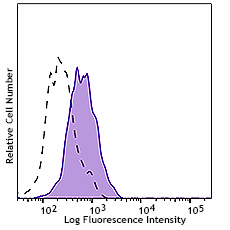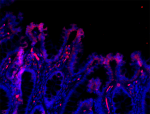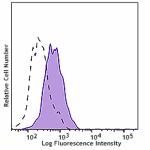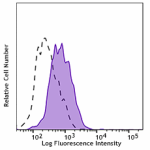- Clone
- S20014A (See other available formats)
- Regulatory Status
- RUO
- Other Names
- Transmembrane protease serine 2
- Isotype
- Mouse IgG1, κ
- Ave. Rating
- Submit a Review
- Product Citations
- publications

-

Human colorectal adenocarcinoma cell line, Caco-2, was stained with purified anti-human TMPRSS2 (clone S20014A) (filled histogram) or mouse IgG1, κ isotype control (open histogram) followed by anti-mouse IgG PE. -

Human paraffin embedded colon tissue was subjected to heat-mediated antigen retrieval with sodium citrate and stained with 5 µg/mL purified anti-human TMPRSS2 (clone S20014A) (red) followed by Alexa Fluor® 555 anti-mouse IgG. Nuclei were counterstained with DAPI (blue). The image was captured by a 20X objective. -

The effect of anti-human TMPRSS2 (clone S20014A) on the ability of cells to migrate was tested by a Matrigel invasion assay. The human colon carcinoma cell line, Caco-2 was serum starved for 24h and seeded onto the top well of Corning® BioCoat Matrigel® Invasion Chamber. Nafamostat (25 µg/mL), mouse IgG1, κ isotype control antibody and untreated cells were used as controls. DMEM media with 20% serum was placed in the bottom well as chemoattractant. After 40h, cells that had migrated to the bottom of the membrane were counted. -

The effect of anti-human TMPRSS2 (clone S20014A) on TMPRSS2 protease activity was tested using a fluorescent protease assay. Recombinant TMPRSS2 was added to wells containing either S20014A, mouse IgG, κ or Nafamostat at 1 µg/mL each. Boc-Gln-Ala-ArgAMC, a protease substrate that exhibits fluorescence when cleaved by proteases, was added at a final concentration of 5 µM. Fluorescence was measured after 3h at 37°C. Protease activity was normalized to wells containing only PBS and Boc-Gln-Ala-ArgAMC.
| Cat # | Size | Price | Quantity Check Availability | Save | ||
|---|---|---|---|---|---|---|
| 378402 | 100 µg | 268€ | ||||
TMPRSS2 is a membrane-anchored protein that belongs to the serine protease family and is involved in many physiological and pathological processes. TMPRSS2 participates in proteolytic cascades and is important in normal physiological function of the prostate. Autocleavage leads to secretion of the protease domain. TMPRSS2 is involved in extracellular matrix disruption and metastasis of prostate cancer cells and activates several substrates, including pro-hepatocyte growth factor/HGF, the protease activated receptor-2/F2RL1 or matriptase/ST14. TMPRSS2 promotes uptake of SARS-CoV-1, MERS-CoV, and SARS-CoV-2 viral particles of by proteolytic cleavage of ACE2 receptor and cleavage of coronavirus spike glycoproteins.
Product DetailsProduct Details
- Verified Reactivity
- Human
- Antibody Type
- Monoclonal
- Host Species
- Mouse
- Immunogen
- huTMPRSS2 transfectant
- Formulation
- Phosphate-buffered solution, pH 7.2, containing 0.09% sodium azide
- Preparation
- The antibody was purified by affinity chromatography.
- Concentration
- 0.5 mg/mL
- Storage & Handling
- The antibody solution should be stored undiluted between 2°C and 8°C.
- Application
-
IHC-P - Quality tested
FC- Verified
- Recommended Usage
-
Each lot of this antibody is quality control tested by formalin-fixed paraffin-embedded immunohistochemical staining. For immunohistochemistry, a concentration range of 5 - 10 µg/mL is suggested. For flow cytometric staining, the suggested use of this reagent is ≤ 2.0 µg per million cells in 100 µL volume. It is recommended that the reagent be titrated for optimal performance for each application.
- Application Notes
-
Additional reported applications include: Flow cytometry.
- RRID
-
AB_2910437 (BioLegend Cat. No. 378402)
Antigen Details
- Structure
- Single-pass type II membrane protein
- Distribution
-
Cell membrane, activated by cleavage and secreted
- Function
- Hydrolase, protease, serine protease
- Interaction
- ACE2, HGF, F2RL1, ST14
- Cell Type
- Epithelial cells, Platelets
- Biology Area
- Cancer Biomarkers, Cell Biology, COVID-19
- Molecular Family
- Proteases
- Antigen References
-
- Hoffman M, et al. 2020. Cell. 181:271-280.
- Yu J, et al. 2010. Cancer Cell. 17:443-54.
- Shen LW, et al. 2017. Biochimie. 142:1-10.
- Gene ID
- 7113 View all products for this Gene ID
- UniProt
- View information about TMPRSS2 on UniProt.org
Related Pages & Pathways
Pages
Related FAQs
Other Formats
View All TMPRSS2 Reagents Request Custom Conjugation| Description | Clone | Applications |
|---|---|---|
| Purified anti-human TMPRSS2 | S20014A | IHC-P,FC |
| PE anti-human TMPRSS2 | S20014A | FC |
Compare Data Across All Formats
This data display is provided for general comparisons between formats.
Your actual data may vary due to variations in samples, target cells, instruments and their settings, staining conditions, and other factors.
If you need assistance with selecting the best format contact our expert technical support team.
-
Purified anti-human TMPRSS2

Human paraffin embedded colon tissue was subjected to heat-m... 
Human colorectal adenocarcinoma cell line, Caco-2, was stain... 
The effect of anti-human TMPRSS2 (clone S20014A) on the abil... 
The effect of anti-human TMPRSS2 (clone S20014A) on TMPRSS2 ... -
PE anti-human TMPRSS2

Human colorectal adenocarcinoma cell line, Caco-2, was stain...
 Login / Register
Login / Register 







Follow Us